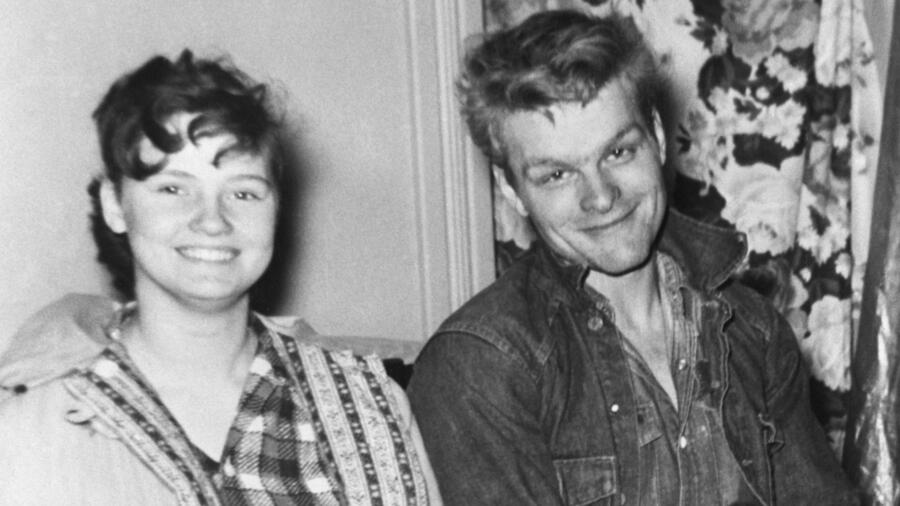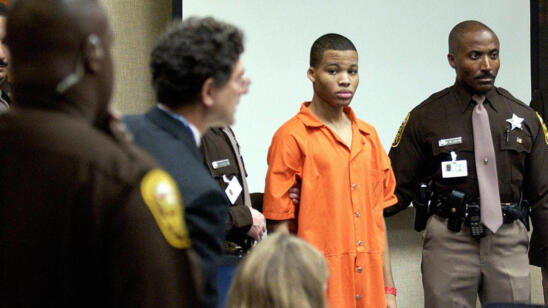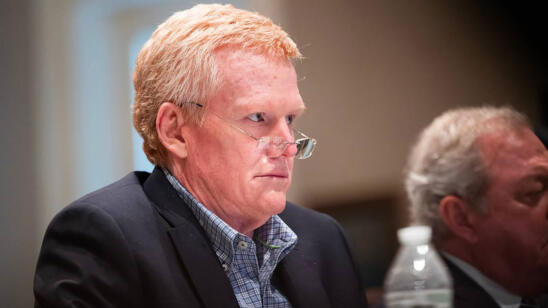Between January 21 and January 29, 1958, Charles “Charlie” Starkweather, then 19, shot and/or stabbed 10 people in Nebraska and Wyoming. His girlfriend, 14-year-old Caril Ann Fugate, was at Charlie’s side during this killing spree.
Caril’s mother, stepfather and half-sister were the first victims. The others killed were: a 70-year-old farmer, two teenagers out for a drive, a wealthy couple and their maid and a traveling salesman. All but one of these later victims were unknown to Charlie and Caril.
After the couple was arrested on January 29, Charlie confessed to all 10 killings, as well as a prior murder he’d committed the previous December. He reveled in the fact that his actions had made him notorious.
Charlie sometimes said Caril had participated in the 10 murders, even those of her family. Caril insisted she thought Charlie was holding her family hostage, and only stayed with him to protect herself and her loved ones.
The state of Nebraska prosecuted Charlie and Caril separately for first-degree murder in the death of teenager Robert Jensen. Charlie was found guilty and sentenced to death in May 1958.
[Stream episodes of Interrogation Raw in the A&E app.]
At her trial, the prosecution painted Caril as a willing accomplice who hadn’t taken advantage of multiple opportunities to escape. In November 1958, Caril was found guilty of first-degree murder. She received a sentence of life in prison.
The state of Nebraska executed Charlie on June 25, 1959. Caril was granted parole in 1976. She never again got into legal trouble.
This murder spree has inspired movies, documentaries, TV episodes, books and even Bruce Springsteen’s Nebraska album. Author Harry MacLean spoke to A&E True Crime about his new book, Starkweather, which explores why this crime spree had a lasting impact and examines the question of Caril’s culpability.
Tell us about your personal connection to the crimes.
I grew up in Lincoln, Nebraska. I lived there when the crime spree started. My older brother knew Charlie Starkweather. I knew a family that had been killed by Charlie Starkweather. [Editor’s note: In the book, MacLean says the family was Chester Lauer Ward and his wife, Clara, the wealthy couple mentioned above. MacLean knew their son.]
I stayed away from this story for a long time because I knew it was going to be difficult for me to go through and relive that time period. But Caril Fugate applied for a pardon in 2018. In 2020, it was denied. That raised the specter of her guilt or innocence.
Most people presumed her guilt, but the actual proof of it was pretty ambiguous. One of the things I want to do [with the book] is bring my skills to bear on the evidence in this case and see if we can resolve her guilt or innocence once and for all.
So Caril might have acted under duress?
What I try to do is bring trauma psychology [into] her situation. Those principles of getting so dissociated by trauma that you can’t make your own decisions, particularly when you have Charlie there.
At the time, could anything have convinced the public that Caril wasn’t a murderous accomplice to Charlie Starkweather?
I tend to think not. The almost universal opinion in Lincoln [at the time], among law enforcement, newspaper reporters and the average citizen, was that Caril was involved in the murders.
The idea that someone could be so traumatized they [would be] incapable of exercising free will in subsequent traumatic situations, that didn’t exist back then.
Why did Charlie and Caril fascinate people?
It’s the end of the ’50s. Here’s this young couple, Charlie looked somewhat like James Dean, and Caril was young and cute. [The question of] Caril’s guilt aside, they turned into buddy spree killers. They were the first, other than Bonnie and Clyde. So there was a space for this and they filled it. They still fill it, in my view.
How important was television in sharing the story of this murder spree?
It was kind of the unholy marriage between television and violence. A man and a girl were on the run for days, which allowed TV [news] to carry it every night. Charlie and Caril were in the living rooms of the American television-watching people. [During his trial], Charlie being led into the jail, into the courthouse, [was] televised. By that point, 88 percent of people in the country had television, so it made it a public spectacle. This was the first time that had happened.
Not only did average people in Lincoln, Nebraska, and New York City or Miami have this experience of seeing the criminals, [but] the John Gacys, the Charlie Mansons, that whole crowd saw it, too. Charlie’s impact on them is somewhat speculative. To me, it created this sense for equally mentally ill people to say, ‘There’s another way to deal with this anger, this lack of a conscience. We’ll go and we’ll create a public spectacle.’
Can you speculate about how Charlie would feel about the fact that he was executed, but Caril went on to live, and is still living, her life?
The fantasy that Charlie developed and lived out was that he was an outlaw, and that he was going to go out in a blaze of glory. Caril needed to be a part of that story for him. That this fantasy of the two of them living on in the afterlife [didn’t] come about, I think that was extremely disappointing to him. And I think it would be disappointing to him to see that she had adjusted so well to life after prison.
Could you talk about how these murders are affecting people even today?
One of the things that I wanted to focus on was not just the suffering of the people who were killed by Charlie, but the suffering that went on with people associated with them.
I talked to Mike Ward, whose parents were killed by Charlie Starkweather. [He] didn’t tell his daughter about what happened to her grandparents for years. Finally, she asked and found out what had happened. He said, ‘I could see then how this generational trauma had played down in her life, and how it was still going to play down in her children’s lives.’
Related Content:
Who Were the 1870s Serial Killing ‘Family’ Known as the ‘Bloody Benders’?
How Diane and Rachel Staudte Killed Their Family With Antifreeze
Why Brenda Lafferty Was Murdered by Her Husband’s Fundamentalist Family


